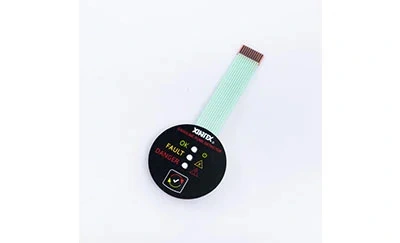
In today's rapidly advancing technological landscape, user interfaces play a crucial role in the functionality and usability of various devices. One such innovation that is revolutionizing user interfaces is the membrane switch. This article explores the significance of membrane switches in modern technology and how they are transforming user interactions.

Before delving into the specifics of membrane switches, it's essential to understand the evolution of user interfaces. From mechanical buttons and knobs to touchscreens and gesture-based controls, user interfaces have undergone significant transformations over the years. Each advancement has aimed to improve user interaction, efficiency, and convenience.
Membrane switches are thin, flexible electrical circuits comprised of multiple layers. These layers typically include a graphic overlay, adhesive spacer, and circuit layer. When pressure is applied to the overlay, it activates the circuit, allowing for input commands.
Graphic overlay: The top layer of the membrane switch, featuring printed graphics and labels.
Spacer: A layer of adhesive material that separates the graphic overlay from the circuit layer.
Circuit layer: The bottom layer containing conductive traces and contact points.
For more details : membrane switch design guide
One of the primary advantages of membrane switches is their durability. Unlike traditional mechanical switches, which are prone to wear and tear, membrane switches can withstand millions of actuations without failure.
Membrane switches offer unparalleled flexibility in design. Manufacturers can customize the graphic overlay to meet specific requirements, including different shapes, sizes, colors, and textures.
Compared to other types of switches, membrane switches are highly cost-effective to produce. Their simple design and efficient manufacturing process result in lower production costs, making them ideal for mass production.
Membrane switches are inherently resistant to environmental factors such as moisture, dust, and chemicals. This makes them suitable for use in various industries, including automotive, medical, and aerospace.
Membrane switches are commonly used in industrial control panels for machinery and equipment. Their rugged construction and reliability make them ideal for harsh environments.
In the medical field, membrane switches are utilized in various devices, including patient monitoring systems, diagnostic equipment, and surgical instruments. Their seamless integration with medical devices ensures precise and responsive user input.
From kitchen appliances to consumer electronics, membrane switches are found in a wide range of everyday devices. Their sleek design and responsive touch make them popular choices for products such as microwave ovens, remote controls, and fitness equipment.
Membrane switches are revolutionizing user interfaces in several ways:
By integrating membrane switches into devices, manufacturers can enhance functionality and user interaction. The tactile feedback and responsive nature of membrane switches contribute to a more intuitive user experience.
Membrane switches offer users a seamless and intuitive interface that enhances their overall experience. Whether it's navigating menus, adjusting settings, or inputting commands, membrane switches provide precise and reliable input.
As technology continues to evolve, membrane switches are evolving alongside it. With advancements such as backlighting, haptic feedback, and capacitive touch sensing, membrane switches are becoming more versatile and adaptive to the needs of modern users.
The future of membrane switches looks promising, with ongoing advancements in materials, manufacturing techniques, and technology. As demand for intuitive and reliable user interfaces continues to grow, membrane switches are expected to play an increasingly significant role in various industries.
In conclusion, membrane switches are revolutionizing user interfaces by offering durability, flexibility, and enhanced functionality. From industrial control panels to consumer electronics, membrane switches are becoming integral components of modern technology. With their ability to withstand harsh environments and provide precise user input, membrane switches are shaping the future of user interfaces.
Are membrane switches waterproof?
Yes, waterproof membrane switch is typically designed to be waterproof and resistant to moisture and other environmental factors.
Can membrane switches be customized with specific designs and logos?
Absolutely! Custom membrane switch panel can be fully customized with graphics, labels, colors, and textures to meet the specific requirements of different applications.
Are membrane switches easy to install and replace?
Yes, membrane switches are designed for easy installation and replacement, making them convenient for maintenance and upgrades.
Do membrane switches require special cleaning or maintenance?
While membrane switches are resistant to dust and debris, regular cleaning with a mild detergent and soft cloth is recommended to maintain optimal performance.
Can membrane switches be used in outdoor environments?
Yes, membrane switches are suitable for outdoor use, thanks to their resistance to environmental factors such as moisture, UV exposure, and temperature fluctuations.